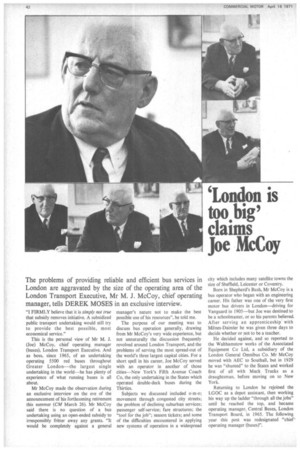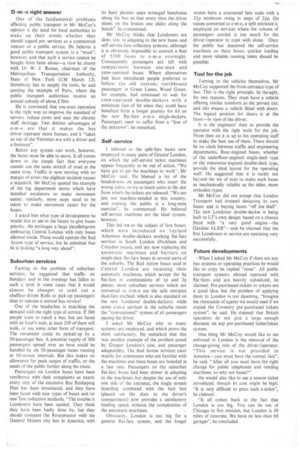'London is
Page 44

Page 45

If you've noticed an error in this article please click here to report it so we can fix it.
too big'
claims Joe McCoy
The problems of providing reliable and efficient bus services in London are aggravated by the size of the operating area of the London Transport Executive, Mr M. J. McCoy, chief operating manager, tells DEREK MOSES in an exclusive interview.
"I FIRMLY believe that it is simply not true that subsidy removes initiative. A subsidized public transport undertaking would still try to provide the best possible, most economical service."
This is the personal view of Mr M. J. (Joe) McCoy, chief operating manager (buses), London Transport Executive. And as boss, since 1965, of an undertaking operating 5500 red buses throughout Greater London--the largest single undertaking in the world—he has plenty of experience of what running buses is all about.
Mr McCoy made the observation during an exclusive interview on the eve of the announcement of his forthcoming retirement this summer (CM March 26). Mr McCoy said there is no question of a bus undertaking using an open-ended subsidy to irresponsibly fritter away any grants. "It would be completely against a general
manager's nature not to make the best possible use of his resources", he told me.
The purpose of our meeting was to discuss bus operation generally, drawing from Mr McCoy's very wide experience, but not unnaturally the discussion frequently revolved around London Transport, and the problems of serving the most spread-out of the world's three largest capital cities. For a short spell in his career, Joe McCoy served with an operator in another of those cities—New York's Fifth Avenue Coach Co, the only undertaking in the States which operated double-deck buses during the Thirties.
Subjects we discussed included o-m-o; movement through congested city streets; the problem of declining suburban services; passenger self-service; fare structures; the "tool for the job"; season tickets; and some of the difficulties encountered in applying new systems of operation in a widespread city which includes many satellite towns the size of Sheffield, Leicester or Coventry.
Born in Shepherd's Bush, Mr McCoy is a bus operator who began with an engineering career. His father was one of the very first motor bus drivers in London—driving for Vanguard in 1905—but Joe was destined to be a schoolmaster, or so his parents believed. After serving an apprenticeship with Milnes-Daimler he was given three days to decide whether or not to be a teacher.
He decided against, and so reported to the Wahhamstow works of the Associated Equipment Co Ltd, a subsidiary of the London General Omnibus Co. Mr McCoy moved with AEC to Southall, but in 1929 he was "shunted" to the States and worked first of all with Mack Trucks as a draughtsman, before moving on to New York.
Returning to London he rejoined the LGOC as a depot assistant, then working his way up the ladder "through all the jobs" until he reached the top, and became operating manager, Central Buses, London Transport Board, in 1965. The following year this post was redesignated "chief' operating manager (buses)". 0 -m -o right answer
One of the fundamental problems affecting public transport in Mr McCoy's opinion is the need for local authorities to make up their minds whether they should regard psv services as a commercial venture or a public service. He believes a good public transport system is a "must", however, and that such a service cannot be bought from fares alone—a view he shares with Dr W. J. Ronan, chairman of the Metropolitan Transportation Authority, State of New York (CM March 12). Somebody has to supply the tools, he said quoting the example of Paris, where the public transport authorities receive an annual subsidy of about £70m.
He is convinced that one-man operation is the right way to improve the standard of service, reduce costs and ease the chronic staff shortage. Two distinct advantages of o-m-o are that it makes the bus driver /operator more human, and it "takes US out of the Victorian era with a driver and a footman".
• Before any system can work, however, the buses must be able to move. It all comes down to the simple fact that everyone cannot use the same stretch of road at the same time Traffic is now moving with no margin of error; the slightest incident causes a standstill. Mr McCoy quoted the.example of the big department stores which have installed escalators to make movement easier; similarly, more steps need to be taken to make movement easier for the buses.
I asked him what type of development he would like to see in the future to give buses priority. He envisages a large parallelogram embracing Central London with only buses allowed inside. These would operate the Red Arrow type of service, but he admitted that he is looking "a long way ahead".
Suburban services Turning to the problem of suburban services, he suggested that traffic on Sundays and in the evenings has fallen to such a level in some cases that it would almost be cheaper to send out a chaffeur driven Rolls to pick-up passengers than to operate a normal bus service!
One of the headaches is matching the demand with the right type of service. If 300 people want to catch a bus, but are faced with an hour's wait, at least 250 of them will walk, or use some other form of transport. The remainder could be picked-up by a 50-passenger bus. A potential supply of 300 passengers spread over an hour could be handled by six 50-passenger buses running at 10-minute intervals. But this makes no allowance for peak surges of traffic, or the needs of the public further along the route.
• Passengers on London buses have been vociferous with their complaints as nearly every step of the extensive Bus Reshaping Plan has been introduced, and they have been faced with new types of buses and/or new 'farecollection methods. "The trouble is Londoners have been spoiled. They think they have been badly done by, but they should compare the Routemaster with the General Motors city bus in America, with its hard plastics seats arranged benchwise along the bus so that every time the driver slams on the brakes one slides along the bench". he commented.
Mr McCoy thinks that Londoners are slow, too, in adapting to the new buses and self-service fare collection systems, although it is obviously impossible to convert a fleet of 5500 buses to o-m-o overnight. Consequently passengers are left with comparisons between one-man and crew-operated buses. Where alternatives had been introduced people preferred to follow the old custom; northbound passengers in Green Lanes, Wood Green, for example, had continued to wait for crew-operated double-deckers with a minimum fare of 9d when they could have benefited from a longer journey for 6d on the new flat-fare o-m-o single-deckers. Passengers seem to suffer from a "fear of the unknown", he remarked.
Self -service I referred to the split-fare buses now employed in many parts of Greater London, on which the self-service ticket machines appear frequently to be out of action. "We have got to get the machines to work", Mr McCoy said. He blamed a lot of the breakdowns on passengers who insert the wrong coins, or try to insert coins in the slot from which the tickets are released. "We are just not machine-minded in this country, and training the public is a long-term exercise-, he commented. He believed self-service machines are the ideal system, however.
This led me to the subject of fare boxes, which were introduced on Leyland Atlantean double-deckers working flat-fare services in South London (Peckham and Croydon areas), and are now replacing the automatic machines and barriers on single-deck flat-fare buses in several parts of the suburbs. The Red Arrow buses used in Central London are retaining their automatic machines, which accept the 4p flat-fare in combinations of lp and 2p pieces; most suburban services which are converted to o-m-o use the split entrance dual-fare method, which is also standard on the new Londoner double-deckers; while some o-m-o services in the suburbs retain the "conventional" system. of all passengers paying the driver.
asked Mr McCoy why so many systems arc employed, and which prove the most satisfactory. He remarked that this was another example of the problem posed by Greater London's size, and passenger adaptability. The Red Arrow services cater mainly for commuters who are familiar with the machines and these buses are boarded at a fast rate. Passengers on the suburban flat-fare buses had been slower in adapting to the machines: but despite the use of only one side of the entrance, the single stream boarding combined with the fare box (placed on the door to the driver's compartment) now provides a satisfactory loading speed, without the complexities of the automatic machines.
Obviously. London is too big for a general flat-fare system, and the longer routes have a coarsened fare scale with a 24-p minimum rising in steps of 2fp. On routes converted to o-m-o, a split entrance is employed on services where the volume of passengers carried is too much for the driver /operator to cope with alone. Once the public has mastered the self-service machines on these buses, quicker loading and more reliable running times should be possible.
Tool for the job Turning to the vehicles themselves, Mr McCoy supported the front-entrance-type of bus. This is the right principle, he thought, for two reasons. They must have a vehicle offering similar comforts as the private car, and this means a vehicle fitted with doors. The logical position for doors is at the front—in view of the driver.
It is the engineers' duty to provide the operator with the right tools for the job. From then on it is up to his operating staff to make the best use of them. There should be no clash between traffic and engineering departments. Rear-engined buses, whether of the underfloor-engined single-deck type or the transverse-engined double-deck type, provide the ideal layout for the operating staff. He suggested that it is surely not beyond the wit of man to make such buses as mechanically reliable as the older, more orthodox types.
Mr McCoy did not accept that London Transport had stopped designing its own buses and is buying buses "off the shelf". The new Londoner double-decker is being built to LT's own design, based on a chassis fitted with "a very good engine—the Gardner 6LXB"—and he claimed that the first Londoners in service are operating very successfully.
Future developments • When I asked Mr McCoy if there are any bus systems or operating practices he would like to copy he replied "none". All public transport systems abroad operated with flat-fares and are heavily subsidized, he claimed. Pre-purchased tickets or tokens are a good idea, but the problem of applying them to London is too daunting. "Imagine the thousands of agents we would need if we copied the Coventry pre-purchased tickets system", he said. He claimed that British operators do not give a large enough discount on any pre-purchased ticket/token system.
One thing Mr McCoy would like to see enforced in London is the removal of the change-giving role of the driver /operator. "This service is not provided in America—you must have the correct fare", he said. "After all you must have the right change for public telephones and vending machines, so why not buses?"
He would also like to see a season ticket introduced, though its cost might be high. "It is very difficult to price such a ticket", he claimed.
"It all comes back to the fact that London is too big. You can be out of Chicago in five minutes, but London is 50 miles of concrete. We have no less than 68 garages", he concluded.




























































































